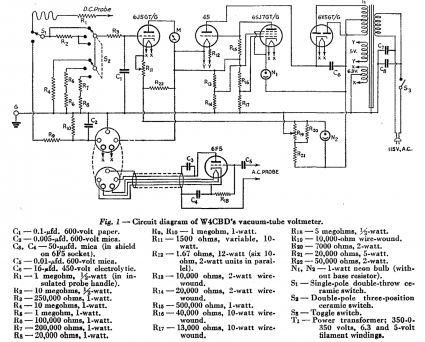One of the features that I like in QST is the 75, 50, and 25 Years Ago column in the back of the book. This month, there are a wealth of interesting, and possibly still useful articles, from those back issues. Here are my selections:
November 1943
The U.S. was still at war in 1943. There is plenty of news about amateurs serving in the armed forces, and the editorial describes plans for a postwar future when we will be back on the air.
A V.T. Voltmeter for A.C. and D.C. by A. D. Mayo, W4CBD. What I found amusing about this is the subtitle, “A simple unit easily constructed from available parts.” It uses four tubes, none of which are readily available anymore. Neither is the meter, for that matter. Here’s the schematic:
November 1968
Incentive licensing went into effect on November 22, 1968. This was a big deal then as General Class licensees, who had full privileges at the time, actually had some privileges taken from them. The editorial touted it as “one of a number of ways to strengthen amateur radio.”
There are a bunch of construction articles in this issue, including “Direct Conversion: A Neglected Technique,” which describes a simple, transistorized 80m receiver, and “ICKEY—An Integrated Circuit Electronic Keyer with Dot and Dash Memories.” Dot and dash memories allow the keyer to do iambic keying. The circuit is relatively simple, and might even be fun to play around with.
November 1993
Two articles caught my eye in the November 1993 issue. The first, “An Update on Compact Transmitting Loops,” looks to be a pretty good article on this type of antenna. There’s been a lot of interest in them lately, so give this article a read.
The second, “A Simple, Two-Tone Audio Generator” describes a three-transistor circuit that that generates one or both of the two audio tones that you’d use for “SSB transmitter testing, power-amplifier linearity checks, and other general audio troubleshooting and adjustments.”

No comments:
Post a Comment